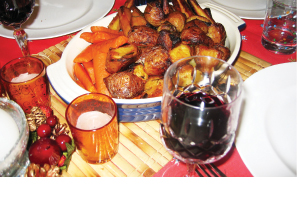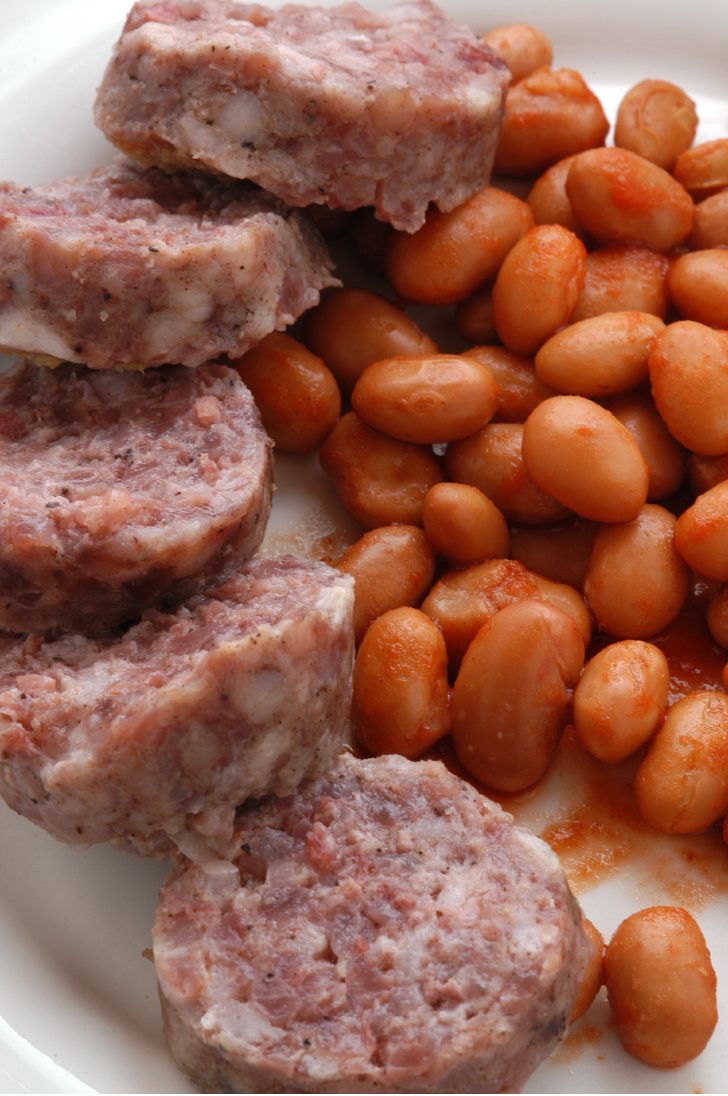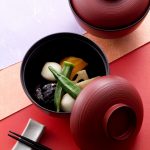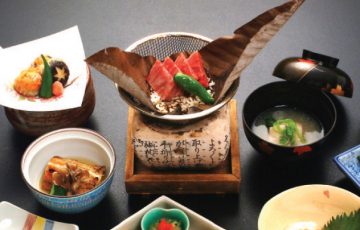 You can change the stuffing, try a new gravy and even add some sautéed aubergines to the vegetable platter to mix things up, but at the end of the day a roast turkey is still a roast turkey. The chances are you’ve been there and done that – done it to death no doubt. Similarly cold noodles (soba) can’t be dressed up any other way; neither can super-sticky rice cakes (mochi) for that matter. This New Year is the time to leave your culinary comfort zone and challenge your taste buds and perhaps your cooking skills to something new.
You can change the stuffing, try a new gravy and even add some sautéed aubergines to the vegetable platter to mix things up, but at the end of the day a roast turkey is still a roast turkey. The chances are you’ve been there and done that – done it to death no doubt. Similarly cold noodles (soba) can’t be dressed up any other way; neither can super-sticky rice cakes (mochi) for that matter. This New Year is the time to leave your culinary comfort zone and challenge your taste buds and perhaps your cooking skills to something new.
There’s a lot to be said for customs and traditions when it comes to celebrating the New Year. They ground us, bond us to our kinfolk, invoke feelings of nostalgia and quite simply make us feel comfortable. But there’s absolutely no harm in taking a brief ‘time-out’ from the annual eating regimen at the end of the year and having a look, or better yet a nibble on something new, perhaps from somewhere you’ve never been.
AT THE STROKE OF MIDNIGHT
As the clock strikes twelve, millions of people around the globe will go through a myriad of food-related rituals that are deeply steeped in history, tradition and liturgy. Take Germany, for example. As one year passes and another begins, German people chow down on herring (a relatively small, particularly oily fish found in the shallow, temperate waters of the North Pacific, North Atlantic and Baltic seas).
The herring is sometimes pickled, sometimes served as filets in wine and many enjoy the dish with a rich creamy sauce. That said, a number of Germans go for the easy option – eating them straight from the jar. It is commonly believed in Germany that herring eaten at midnight will bring good luck for the coming year.
This lucky little fish is often washed down was a festive drink called Feuerzangenbowle. This punch-like cocktail with its ingredients including copious amounts of red wine and rum, as well as oranges, lemon, cinnamon and cloves, will warm the cockles of your heart and have you welcoming the year ahead with a big, inebriated smile. Two or three glasses of this spirituous tipple, will have you flat on your back and waking up on January 2nd wondering where the last 24-hours went. You have been warned!
In Spain, Portugal, Mexico, Cuba,Ecuador, and Peru, it is tradition to eat twelve grapes at the stroke of midnight, one for each month in the coming year. People often say the name of the month as they pop a grape into their gob and if the grape tastes sweet, it is said that that particular month will be a good one. In Peru, in fact, there is a thirteenth grape. The eating of this grape symbolizes good fortune and success in the coming year.
 A hidden almond in one of the bowls of rice porridge served to family and friends at the end of the year, is a Norwegian tradition also shared by some of its neighbors. The lucky person who finds the almond in his or her bowl will enjoy a year of prosperity and success. In Sweden and Finland, popular belief maintains that the one who eats the almond will be married the following year, whereas in Iceland and Denmark the one who finds it will get a prize, such as a pig made entirely of marzipan.
A hidden almond in one of the bowls of rice porridge served to family and friends at the end of the year, is a Norwegian tradition also shared by some of its neighbors. The lucky person who finds the almond in his or her bowl will enjoy a year of prosperity and success. In Sweden and Finland, popular belief maintains that the one who eats the almond will be married the following year, whereas in Iceland and Denmark the one who finds it will get a prize, such as a pig made entirely of marzipan.
However, for the Danes it’s not all about porridge and almonds. There’s a tradition of saving old dishes and throwing them at the thresholds of the houses of your friends and near ones. Apparently, it’s actually a good sign to find the entrance of your house littered with old broken dishes on New Year’s Day. These broken dishes symbolize the importance of friendship and good relationships throughout the coming year. Once the neighborhood vandalism ceases and people have licked their bowls clean of porridge, Danish people’s last order from the New Year’s Eve menu will be some boiled cod, or stewed kale and pork. All these food items traditionally bring good luck and happiness to the Danish people in the ensuing days of the New Year.
On the evening of February 13 (2010), more than a billion people in China will be eagerly awaiting the arrival of their New Year – The Year of the Tiger. Just before the clock strikes midnight, family members in China meet to prepare small dumplings together. Each person in the family has a clear and specific role to play in the dumpling preparation process. Rolling the dough could be one person’s duty, whilst another may be charged with the responsibility of filling said dumplings.
A third person in the chain is in charge of sealing the dumplings and placing them in the soup to cook. Eating the dumplings at midnight – as the last meal of the outgoing year and the first meal of the New Year – represents hope for abundance and prosperity in the coming year. It is also customary to hide a coin or sweet in one of the dumplings, and whoever finds it can expect particularly good luck throughout the year.
COTECHINO CON LENTICCHIE
In Italy La Festa di San Silvestro and Il Capodanno are effervescent festivals that involve bidding farewell to the old year and looking to the year ahead. The festivals are comprised of food, drink and dancing (as any festival worth its salt should be).
As with most Italian festivals, food plays a major role. Families and friends get together for a huge feast of which the main feature is the humble lentil bean. This bean actually symbolizes money and good fortune for the coming year. Traditionally the dinner in many parts of Italy also includes a cotechino, a large spiced sausage, or a zampone, stuffed pig’s trotter. The pork symbolizes the richness of life in the coming year.
Regardless of whether or not you’re Italian, why not rustle up some Cotechino con Lenticchie this New Year to impress your friends and family? It’s a relatively easy dish to prepare, is healthy and the ingredients can be found at most international supermarkets with a delicatessen.
Ingredients
1 onion
500g lentils
2 cloves garlic
Fresh mint
Salt and pepper
1 Cotechino salami
Olive oil
 Real Cotechino can be found in any good Italian delicatessen. In a little olive oil, cook one sliced onion until it starts to become transparent. Add 500g of lentils and about 1.5 liters of hot water. Add 2 cloves of garlic and some fresh mint. Cover the pan and simmer gently (for about an hour) until the lentils are cooked and little liquid remains. Then just season to taste with salt and pepper.
Real Cotechino can be found in any good Italian delicatessen. In a little olive oil, cook one sliced onion until it starts to become transparent. Add 500g of lentils and about 1.5 liters of hot water. Add 2 cloves of garlic and some fresh mint. Cover the pan and simmer gently (for about an hour) until the lentils are cooked and little liquid remains. Then just season to taste with salt and pepper.
Meanwhile, prick the cotechino in several places with a fine skewer, put it in a saucepan, cover with cold water and simmer slowly for about the same amount of time. Alternatively the cotechino can be cooked with the lentils. Tip the lentils into a serving dish, slice the cotechino thickly and arrange on top and serve. Simple, elegant and quintessentially Italian. “Buon appetito!”
HOPPIN’ JOHN AND SKIPPIN’ JENNY
This African-American dish is found in most of the Southern states of the US, but is mainly associated with the Carolinas whose cuisine is known as ‘Gullah’ or ‘Low Country.’ Traditionally it’s a high point of New Year’s Day and a shiny dime is often buried among the black-eyed peas just before serving. Whoever gets the coin in his or her portion is assured good luck throughout the year. For maximum good luck in the new year, the first thing that should be eaten on New year’s Day is Hoppin’ John. At the stroke of midnight on New Year’s Eve, many southern families toast each other with champagne and a bowl of Hoppin’ John. Here’s how to get your John a Hoppin’.
Ingredients
1 cup dried black-eyed peas
¼ lb. bacon slab or 4 slices thick-cut bacon
1 medium yellow onion, coarsely chopped
6 cups chicken broth
½ tsp. freshly ground black pepper
1 tsp. crushed red-pepper flakes
1 tsp. salt
1 can crushed Italian tomatoes
1½ cups long-grain rice
To begin with wash the peas in a strainer and place them in a medium bowl and allow them to soak for 4 hours in fresh water. Cook the bacon in a 4-quart pot over a medium-high heat, rendering the fat in the pot for 5 minutes. With a slotted spoon, scoop the bacon out onto a plate lined with paper towels and set aside. Add the onion and cook for about 5 minutes or until softened. Pour in the broth, freshly ground black pepper, red-pepper flakes, and salt, and bring to a boil. Let the broth boil vigorously for 10 minutes, then add the drained peas. Boil gently over medium-high heat, uncovered, until the peas are tender but still have some ‘bite’, this should take about 25 minutes. Add the tomatoes and the rice to the pot, cover, reduce the heat to low and simmer vigorously for 20 minutes until most of the broth has been absorbed, but the rice and peas are still very moist. Remove the pot from the heat and allow the Hoppin’ John to steam whilst covered (all the liquid should be absorbed after 5 minutes). Fluff the black-eyed peas and rice with a fork and arrange on a serving dish. Sprinkle the cooked bacon over the top, and serve. Skippin’ Jenny is just leftover Hoppin’ John by the way!
TTKOK KUK
Similar in some ways to the hearty Vietnamese soup known as pho, traditional Korean Ttok kuk consists of thinly sliced rice cakes served in a slow-simmering beef broth. Koreans eat Ttok kuk during the Lunar New Year to ensure luck and longevity. Children often make a game out of the dish by eating the same number of rice cakes as their age. The dish can be supplemented with mandu, Korean meat-and-vegetable dumplings. Why not bring a little Korean comfort food into your home this New Year’s?
Ingredients
½ lb. beef brisket
2 cloves garlic
1 tbsp. instant beef or vegetable bouillon
1 pack (32 ounces) Korean oval rice cakes
2 eggs
2 tbsp. sesame oil
1 tbsp. soy sauce
1 tsp. sesame seeds
1 tsp. salt (or add to taste)
3 scallions
Bring 3.5 liters of water to the boil in a large pot and add the brisket, garlic, and bouillon. Reduce the heat and simmer for 3 hours or until the liquid reduces to two-thirds. Soak the rice cakes in cold water for 1 hour and remove. Scramble the yolks and whites of the eggs separately. Using one tablespoon of the sesame oil, fry the yolks into a thin omelet in a nonstick skillet over high heat for one minute per side or until set. Fold or roll up the omelet and slice into thin strips.
Repeat with the egg whites and set aside. Remove the brisket from the pot but keep the broth. Slice it into thin strips and combine with the soy sauce, sesame seeds, and the remaining sesame oil. Increase the heat under the broth to high. When it comes to a rolling boil add the rice cakes. Reduce the heat to medium and simmer the rice-cake ovals for 5 minutes, or until softened. Return the marinated beef to the soup and add salt to taste. Ladle the steaming hot soup into large bowls. Garnish with sliced egg yolks, egg whites, scallions and dive in!
In whatever directions they may take you, as you and yours celebrate the New Year, enjoy your culinary excursions!
By James Souilliere
From WINING & DINING in TOKYO #36















Recent Comments